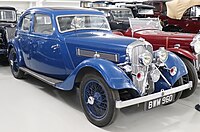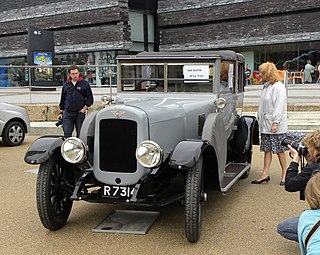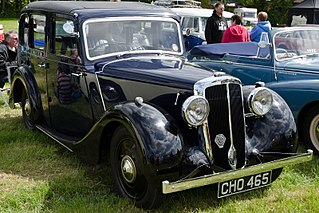Rover 14 P1 (1933–1938)
| Rover 14 P1 | |
|---|---|
 1935 Fourteen 6-light saloon P1 | |
| Overview | |
| Manufacturer | Rover |
| Production | 1933–1938 |
| Body and chassis | |
| Body style |
|
| Powertrain | |
| Engine | 1577 cc straight 6 |
| Transmission |
|
| Dimensions | |
| Wheelbase | 2,921 mm (115 in) [1] |
| Length | 4,191 mm (165 in) to 4,445 mm (175 in) |
| Width | 1,575 mm (62 in) to 1,588 mm (63 in) |
| Kerb weight |
|
| Chronology | |
| Predecessor | Pilot 14 |
| Successor | Rover P2 |

registered April 1938
The Rover Fourteen P1 was announced in early September 1933 [6] to replace the interim Pilot 14. It had been seen previously by the public in prototype in the RAC Rally at Hastings as the competition winning Rover Speed Fourteen 4-door coupé.
The B H Thomas six-cylinder ohv engine from the Pilot had a capacity of 1,577 cc. Maximum power output of 48 bhp (39.7 kW) at 4,600 rpm [7] and a top speed of 111 km/h (69 mph) were claimed. [1]
The car had no luggage compartment and the spare wheel and tyre were carried in a metal case positioned vertically above the back bumper with a fold-out luggage rack.
Streamline
During 1934 an extra new body shape was offered designated Streamline saloon and, more compact, a Streamline coupé. Both were a fastback shape, the rear portion not unlike the Riley Kestrel body. The four-door Streamline coupé's roof left even less headroom for the rear passengers than the restricted space available to backseat passengers in the Streamline saloon. [8]
For the 1934 Olympia Motor Show the wheelbase was extended by 3 inches to 115 inches and the track widened by ½ an inch. The lengthened wheelbase put the seats well within the wheelbase. [9]
Speed Fourteen
The Speed engine had three semi-downdraught carburettors in place of the standard single down-draught instrument, specially streamlined ports and manifolds and a high-compression cylinder head. Output was 54 bhp at 4,800 rpm. [6]
- 1935 Speed Fourteen sports saloon P1
- with flush fitting sliding roof
- 1936 Speed Fourteen 4-door Streamline saloon
Road test of a Speed Fourteen Hastings coupé
The Times' correspondent thought the car travelled rapidly and smoothly and found the lines of the body pleasing. Front seat access, he said, is easy but the rear seat though having good leg and elbow room and just enough head clearance is as difficult as most sports models to climb into. The car seemed "well-found" - two wipers with two motors, a fitted tool tray below the instrument panel, a windscreen with a handle and concealed chain for security. The signal lever has an automatic return. Driving position, location and action of all controls were all fine. There is a harmonic stabiliser. Though a sports car the engine is not fussy or hesitant at low speeds. The best speed on the open road was about 80 miles an hour. [10]
Road test of a Fourteen 6-light saloon
The standard four-door saloon was tested in April 1937 with a wheelbase 3 inches longer. Although it had the less highly tuned engine and reached just 70 mph on the straight the tester described it as fast for its size, stable on the road. ". . . with the even travel, speed is deceptive" [11]
- More powerful engine
From the summer of 1936 Rover customers wishing to combine the Fourteen's virtues with better performance could opt for the Rover 16 which combined the same body with a larger engine. [12]





















